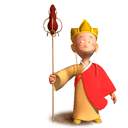 Buddha (Phật Tổ) (c. 563-c. 483 BC), the founder of Buddhism, born in the Lumbini park near Kapilavastu, in present-day Nepal near the Indian border. The name Gautama Buddha by which the historical Buddha is known is a combination of his family name Gautama and the epithet Buddha, meaning "Enlightened One" .(người thông tuệ)
Buddha (Phật Tổ) (c. 563-c. 483 BC), the founder of Buddhism, born in the Lumbini park near Kapilavastu, in present-day Nepal near the Indian border. The name Gautama Buddha by which the historical Buddha is known is a combination of his family name Gautama and the epithet Buddha, meaning "Enlightened One" .(người thông tuệ)All the surviving accounts (tài liệu, lời kể) of the Buddha's life were written many years after his death by idealizing followers rather than by objective historians. Consequently, it is difficult to separate facts from the great mass of myth and legend in which they are embedded. The historical details of the Buddha's life are therefore hard to establish, but perhaps enjoy no privileged claim over the appended tales and doctrines.
Early Life
The Buddha was born the son of the head of Kapilavastu's Sakya warrior class, with the personal name of Siddhartha; after his enlightenment, he was known also as Sakyamuni (Sage of the Sakyas). Legend has it that his mother, Mahamaya, dreamed shortly before her son's birth of a beautiful white elephant which entered her womb. She died soon after the Buddha was born, and he was reared in the greatest luxury by his father and step-mother. The new-born child was reputedly examined by Brahmans, who predicted his destiny as either a universal monarch or a Buddha. The Buddha apparently showed an early inclination to meditation and reflection, displeasing his father, who wanted him to be a warrior and ruler rather than a religious philosopher. In his own discourses, the Buddha recalled that he meditated and entered his first trance while still a boy. Yielding to his father's wishes, he married at an early age and participated in the worldly life of the court. He had a son, whom he named Rahula ("Bond").
According to tradition, the Buddha began his search for enlightenment at the age of 29, when he encountered an aged man, a sick man, and a corpse, and suddenly realized that suffering is the common lot of humankind. He then came upon a mendicant monk, calm and serene, whereupon he determined to adopt his way of life and forsake family, wealth, and power in the quest for truth. This decision, known in Buddhism as the Great Renunciation, is celebrated by Buddhists as a turning point in history.
Resolved, the Buddha immediately left palace, wife and child, and went out into the world. Wandering as a mendicant over northern India, he took instruction from some famous Brahman teachers, but soon exhausted their capacity to teach him. He continued his search, eventually settling at Uruvela, near present-day Gaya, with five followers, one of whom had been among the Brahmans who had seen the marks of Buddhahood on the newborn Siddhartha's body. For almost six years he strove to achieve enlightenment through the severest asceticism, becoming a virtual living skeleton. Finding this method fruitless, he gradually resumed a normal diet, restored his health and modified his ascetic regime, in the process losing his disciples, who deplored what they saw as this new laxity.
Enlightenment (sự thông tuệ, đắc đạo)
At the age of 35, the Buddha achieved his breakthrough to complete enlightenment while sitting under a bo tree in Buddh Gaya, in what is now the state of Bihar. He reportedly sat down one evening and determined not to rise until he had reached nirvana. First he was assailed by the demonic armies of Mara, lord of illusion, who sought to distract him. Mara retired vanquished, unable to break his concentration, and the Buddha went on meditating. During the night he passed through successively higher levels of awareness, gaining knowledge of his former lives and the "divine eye" which can follow the reincarnation of all beings. Finally he grasped the Four Noble Truths: that all existence is suffering; that suffering is caused by ignorance and attachment. At this point the Buddha experienced the Great Enlightenment, which revealed the way of salvation.
The Buddha as Teacher
Once he had decided to preach the discovered dharma (law) he had perfected, the Buddha went first to his former disciples near Benares (Varanasi). Overcome by his sincerity, they accepted him as their teacher and were then ordained as monks. Shortly afterwards he preached his first sermon in the Deer Park nearby. This sermon, the text of which is preserved, contains the gist of Buddhism.
Accompanied by his disciples, the Buddha travelled through the valley of the River Ganges, teaching his doctrines, gathering followers, and establishing monastic communities that admitted anyone regardless of social status. He returned briefly to his native city and converted his father, his wife, and other members of his family. A wealthy admirer subsidized the building of a monastery at Savatthi (Sanskrit, Sravasti) which became the Buddha's main residence and the centre of his teaching efforts. Other monasteries sprang up in the major cities along the Ganges.
The Buddha's Death and Reputation
After a lifetime of missionary activity, the Buddha died in Kusinagara, Nepal, as a result of eating contaminated food. He was 80 years old.
Buddha was one of the greatest human beings, a man of noble character, penetrating vision, warm compassion, and profound thought. Not only did he establish a great new religion, but his revolt against hedonistic, ascetic, and spiritualistic extremes, and the caste system, deeply influenced Hinduism itself.
Tác giả: chưa biết
Nguồn ảnh: chưa biết
Nguồn bài: trang web của thầy tôi Thái Bá Tân




Không có nhận xét nào:
Đăng nhận xét